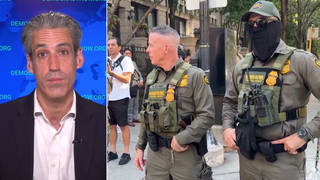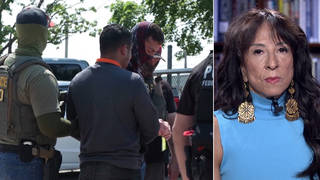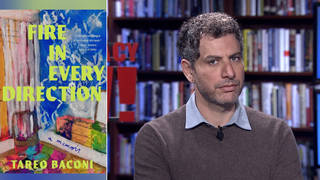
Guests
- Shane Harrisstaff correspondent for National Journal. His book, just out, is The Watchers: The Rise of America’s Surveillance State.
For his new book, The Watchers: The Rise of America’s Surveillance State, National Journal correspondent Shane Harris spoke to the key architects of the US government’s surveillance programs over the past quarter-century and tells the story of how spying on US citizens has become both easier and legal and is now the cornerstone of the Obama administration’s national security strategy. But Harris argues that while this strategy has made it simpler for the US government to spy on every American and millions of others around the world, it is much harder to identify actual dangers. [includes rush transcript]
Transcript
JUAN GONZALEZ: As civil liberties advocates continue to decry the increased surveillance that has come to mark our everyday lives, we turn now to a book that chronicles the rise of America’s surveillance state.
National Journal correspondent
Shane Harris spoke to the key architects of the US government’s surveillance programs over the past quarter-century and tells the story of how spying on US citizens has become both easier and legal and is now the cornerstone of the Obama administration’s national security strategy.
AMY GOODMAN: But Harris argues while this strategy has made it simpler for the US government to spy on every American and millions of others around the world, it’s much harder to identify actual dangers.
The book is just out. It’s called The Watchers: The Rise of America’s Surveillance State. Shane Harris joins us now in Washington, DC.
Shane, you’ve just been listening to this whole conversation about the kids having their webcams turned on, without their knowing it or without their parents knowing it, by the school to see what they’re doing in their bedrooms. When you did the research for The Watchers, what most shocked you about the abilities of this country to monitor us?
SHANE HARRIS: Yeah, I think that one of the things that I found most surprising was just the extraordinary volume of information, the quantity of information, that intelligence agencies were gathering, specifically the National Security Agency, which is chiefly responsible for intercepting electronic communications, like phone calls and emails, and of course, as we all know, was doing that for many years under secret authorities from President Bush that allowed it to go outside the normal process of having to get a court order to collect that. And we knew that that was occurring. But what shocked me was just the extraordinary amount of it and the great lengths that the NSA actually went to to try and suck in huge amounts of information and analyze it as it was moving on networks in real time.
They actually, in around 2004 and 2005, experimented with a very sophisticated and terribly expensive kind of new database that would allow them to just ingest huge quantities of information from telecom networks and then just sort of monitor that traffic as it was moving and kind of pulsing in real time. And it sort of sounds like something that you would imagine that they would already be able to do, but the scale of the information that we’re talking about here is literally so large that it even choked NSA’s computers, which were fairly sophisticated after the 9/11 attacks, that they had at the time. They had to actually build new computers just to take in all this stuff.
JUAN GONZALEZ: And you’ve written how, for instance, with the situation with the Christmas Day bomber, that the National Counterterrorism Center has all of this information coming in, but it’s all on separate databases that — and part of the efforts of the Obama administration now is to merge these databases and create greater ability to do dynamic searching. Could you expand on that?
SHANE HARRIS: Yeah, sure. Well, the National Counterterrorism Center is this — basically this office building outside of Washington, where — it was set up not long after the 9/11 attacks, and there are analysts there from the FBI and the CIA and the NSA. And the idea is that they should all be under one roof sort of sharing information that they’re collecting.
Well, how that’s actually worked out is that there are more than two dozen different networks run by these different agencies, none of which are actually all connected. And these are networks on which they’re running their own particular intelligence, whether that be signals intercepts from NSA or reports from human sources at the CIA. And then, within those networks, there are something like eighty different data streams of unique kinds of intelligence. None of that has really been merged and collected in a way that analysts can search through all of it at once.
So what ends up happening is that a typical analyst at the National Counterterrorism Center, somebody who is responsible for trying to make all these different connections among these fragments of information, will actually have about half a dozen desktop computers on his or her desk that are connected to these separate networks, which, for security reasons and reasons of bureaucratic turf, the agencies have just never connected. So, I mean, imagine trying to go out and search for a particular keyword or a concept, but having to do it in separate databases. It’s almost like a manual process. There’s nothing that’s ever been put in place that kind of sets over the top of those and allows the analyst to go in there and perform, you know, the equivalent of a Google search or something that we would take for granted. So, this was one of the problems before the Christmas Day attack, was that there were all these silos of information on this individual who ended up taking the bomb onto the airplane, and nothing was connecting them.
You know, this is one of the things I found in the research of the book that was sort of baffling. You would think that eight or nine years now after the 9/11 attacks, the government would have done a better job just getting management over the information it already had. And instead, it seemed to focus much more on going out and collecting information that previously was restricted and that was considered private. And there’s been very little actual emphasis placed on trying to manage the information once it gets into government hands. It’s been this almost obsessive focus on collecting the data and paying less attention onto trying to make sense of it on the back end. And I think that’s very troubling.
AMY GOODMAN: Shane Harris, has President Obama changed surveillance policies of President Bush? I mean, you wrote about the whole scandal around Total Information Awareness, John Poindexter’s program. He’s driven out, though TIA takes on other forms within the National Security Agency. If you could address both those points, where the NSA is in all of this and also where Obama stands.
SHANE HARRIS: Right. Well, to your first question, President Obama did not dramatically change at all the surveillance policies of his predecessor. When he was a candidate, when he was running for office, he actually took a fairly strong and, I think, rather principled stand against new surveillance laws that were being debated in Congress at the time, which would have granted legal authority to much of what the Bush administration had been doing and the NSA had been doing after 9/11 in secret and arguably outside the surveillance laws. So Obama was against that, in principle. He didn’t want to, he said, expand the government’s surveillance powers. He also didn’t want to grant immunity to the telecommunications companies who had participated in this secret surveillance program for five or six years. And he actually threatened to filibuster any bill that would have that immunity provision.
But as he got closer to an assured nomination and as some of his intelligence advisers began talking to him about what these surveillance programs do and what they thought the value to be gained from them was, he flip-flopped. He changed his position. He said he was going to support new surveillance authorities. And I think what happened there is, as he got closer to the day that he was likely to become president and these would become his executive powers, I think he realized that they could be very valuable tools, and he wasn’t willing to give them up, because they were executive authorities. And I think also he didn’t want to be the one responsible for having missed something on his watch, and he wasn’t going to essentially dispense with a valuable intelligence gathering tool like this.
You know, NSA’s role in all of this — you asked the question about that and where it fits in with John Poindexter — is really central. I mean, the National Security Agency, when we talk about our intelligence organizations going out and vacuuming up huge amounts of electronic data, they are the primary vacuum, if you like. They have the capacity to monitor emails, to monitor phone calls, to take other electronic transactions, and to bring it back into the agency and try and sift it out.
And this was something that John Poindexter was very interested in doing when he came back to government after the 9/11 attacks. I mean, most remember Poindexter as the mastermind of the Iran-Contra affair in the mid-’80s when he was the national security adviser for President Reagan. But he had been chasing this kind of elusive dream of could the government build a technological system capable of going out and ingesting these huge amounts of information and trying to find patterns that indicated terrorist activity in that electronic noise, really.
And NSA watched this very closely and became very enamored of the idea. And when Congress pulled the public funding on Poindexter’s research project, called Total Information Awareness, NSA changed the names of the programs and then secretly took them up and began experimenting with them behind closed doors. So you see this kind of vision of John Poindexter really catching fire at the National Security Agency, and they’re still captivated by it today, this notion that you can go out and essentially ingest the entire ocean of information and find a few vital clues in it that leads you to a terrorist plot in the offing or to a suspect. And unfortunately, the track record just doesn’t prove that out.
AMY GOODMAN: Shane Harris, this is part one. He’s author of The Watchers: The Rise of America’s Surveillance State.











Media Options